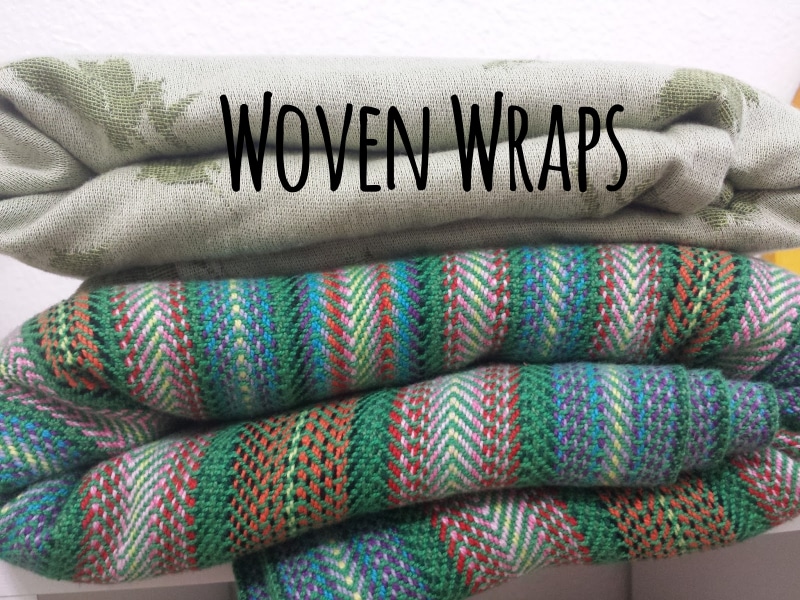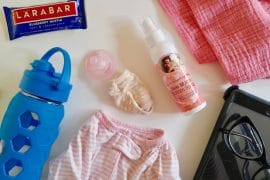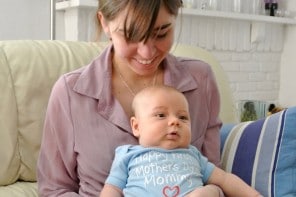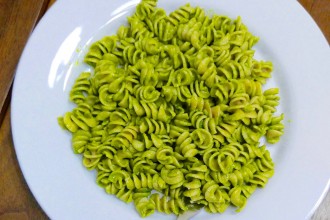Woven Wraps: Falling Down the Rabbit Hole
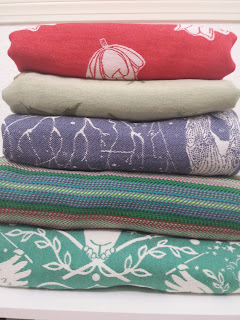 |
| Doeck Tulipa Rosso, Pollora Forest Fairies, FireSpiral Octarine Midwinter, KHR Baby Spring Flowers, Cari Slings Owl Post |
*Disclaimer: I am warning you now. Woven wraps are strangely addicting. I know, I know… An obsession with fabric? Well, let’s just say there is a reason people collect these things. Once you start…you’ll get it. You are warned.
Each type of baby carrier has it’s own qualities, differences, brands, etc. But woven wraps are really a category all on their own simply because of all the options. Choice of price, pattern, size, material, weight, etc. makes for a seemingly endless list of possibilities. And not to mention the woven wrap terms! So let’s break it down into those categories.
Terms:
–Airy: When a wrap is not very dense and allows for airflow
–Bounce: this quality is if a wrap has give when the wearer moves around with the baby
–Broken thread: if a thread is pulled and then broken; if it is tied into a secure knot, it will not affect safety
–CISO/ISO/DISO: Casually in search of/In search of/ Desperately in search of; descriptions used by people looking for a particular wrap
–Cush: the amount of give a wrap has; typically translates to a marshmallow like feel on the shoulders
–Dense: this quality is attributed to a wrap with threads very closely woven together
–Dry: this is a quality that means the fabric feels a bit more rough and dry in hand
–Felting: damage to a wool wrap; the fibers get too agitated resulting in fuzziness, shrinkage, and the formation of little balls; a felted wrap is not safe for babywearing
–Glide: the slipperiness of the fabric; how easily it slides onto itself when making passes and pulling tight
–Grip: the way the fabric moves against itself; grippier wraps stick to itself and it is harder to pull the fabric tight, but once it is put into place, it stays
–Moldable: If a wrap hugs close to your body and you baby, like a second skin, it is considered moldable. Wraps with this quality are easier to wrap with.
–MV: market value
–Natty: natural, undyed fibers
–Permacrease: when a wrap is left folded too long, it runs the risk of having a permanent crease; unless very worn, it is typically safe to still use
–Pull: when a thread is pulled out from the wrap; can be woven back in with patience and a steady hand; doesn’t affect safety but beware that it can become a broken thread
–RV: retail value
–Saggy: if a wrap stretches out while wearing, it is considered saggy; usually means unsupportive
–Slippery: when fabric slides easily against itself
–Shorty: a shorter size wrap; typically size 2 to 4
–Supportive: this quality is given to wraps that hold heavier children without sagging
–Wet: a quality of a wrap that is slippery and cool feeling
But isn’t it just fabric?
It is possible to go to a fabric store and find fabric that has been woven in a similar way. Many people make homemade wraps using Osnaburg fabric. But the difference between fabric store material and a woven wrap is that wovens are safety tested. They tested to make sure that they can withstand the weight of a child as well as the wear and tear of daily use. The dyes are also typically baby-friendly as many babies love to suck and chew on the fabric. Plus, a professional company or wrap maker has ensured that the seams are secured and do not run the risk of unravelling. All of these safety qualities and better materials mean that woven wraps have a higher price tag.
Price:
 |
| Pavo Granite Etini: a pricier brand |
Prices on woven wraps can be tricky. There’s the retail price and the market value price.
The retail price varies depending on the quality of the material, the type of material, the complexity of the weave, and to some extent, the brand. Cheaper woven wraps are not necessarily bad, they just may not be as soft or thick or well made as more expensive woven wraps. More affordable wovens are easy to find and will still do a great job carrying and snuggling a baby. Higher quality materials, like organic cotton or pima cotton, as well as the type of material, like silk or cashmere, are more expensive for the manufacturer. This makes the retail price higher. Often, very expensive wraps will have blends of multiple materials like cotton, silk, and wool. Each blend gives a wrap a different feel and different wrapping qualities. Also, if a wrap company makes a woven with a particularly complex weave, the price is higher because the process is more complicated. The more expensive, or high end, wrap companies all use better quality materials and more complex weaving, but their name often lends to people seeking them out more.
Market value on a woven wrap is what other people will pay for it second hand. There is a huge market for woven wraps on places like Facebook. There are multiple places to buy, sell, and trade them. Many wraps will sell for around or lower than retail. These wraps are typically easier to find or they are already pretty cheap. Wraps that were made in smaller quantities and more sought after will fetch much higher than the retail price. There are many “budget wraps” that sell for under $100 retail but will sell for much higher on a Facebook swap, just depends on what’s popular at the time. Market value changes often and quickly for this reason.
Patterns, colors, and designs:
 |
| Doeck Tulipa Rosso |
It’s pretty easy to find a wrap that will suite your personal style and preference. There are just way too many to even begin to list but let’s say you want a red wrap with flowers. There’s Oscha Roses Aphrodite, Doeck Tulipa Rosso, and Kindred Paia Watermelon… and that’s just off of the top of my head. I’m sure many more could be found with a couple of quick searches. Sometimes the weave itself lends to the pattern of the wrap. Whatever the design may be, it will affect the wrapping qualities. A complex and busy pattern will make a wrap more “grippy”, while a plainer design with open spaces will make it glide easier. The weave can also determine whether or not a wrap is “cushy”. If the design is contrasted enough, it can create little air pockets that can translate into cush.
Size:
 |
| Silver Lining Slings Pipe Dream Shiro as a shorty |
Woven wraps typically come in size 2-7, but sometimes will be offered as a size 1 or even an 8. The sizes average as the following:
Size 2: 2-2.2 meters
Size 3: 2.5-2.7 meters
Size 4: 3.7-3.9 meters
Size 5: 4.2-4.3 meters
Size 6: 4.6-4.9 meters
Size 7: 5.2-5.4 meters
Size 8: 5.5-5.8 meters
The size that you get depends on what carries you want to do as well as the size of both you and your child. Your “base size” is the size that you can do Front Wrap Cross Carry (FWCC), which is the easiest to start with, as well as a large range of other carries. Most average sized women are a base size 6. Smaller sizes, or “shorties”, are used for specific carries like a Rucksack carry or Rebozo. This video is good for demonstrating shorty carries. This channel has a great list of many carries and what size to use for each one.
Woven wraps also can vary by width, but this is not usually included as part of the size and varies by wrap and manufacturer. For example, Didymos makes wraps more narrow than Pavo. Narrow wraps are great for smaller babies as wider wraps can swallow them up. I use wide wraps with my big boy now because it goes higher on his back and is more secure.
Material:
 |
| FireSpiral Slings Octarine Midwinter |
Although cotton is the easiest to find, there are so many different blends to choose from. Most wraps that have more than one type of material have cotton as a base, but there are wraps that are completely made of something different like linen or silk.
Cotton: This material is very easy to care for and typically requires no special treatment. A gentle wash, dry, and steam iron are perfect and it’s fairly easy to get stains out. Whether or not it is supportive depends on the actual wrap (density, weave, quality of the cotton, etc.) I have tried cotton wraps that were not supportive enough for my toddler, but on the other hand, my most toddler worthy wraps are 100{33a567f4c07c8c413e7e9e9d9be2242a7b8a132d09d89d1c03680e3e8f95cc61} cotton.
Hemp: Hemp is known for being very supportive of heavier children. It breaks in quickly to be buttery soft, so it’s a great choice for a smaller baby as well. Hemp loves heat, so ironing it will only help it to become softer, but beware of over-drying. It’s easy to care for as it can be thrown in the washer and dryer with no problem. It’s not great for hot climates because it holds heat in so well.
Linen: Linen is also very supportive, but is much more cool and breathable. It’s great for hot climates and heavy babies but the right one can be great for a newborn. This material requires breaking in and, depending on the wrap, it could take quite a bit of work. Once broken in, linen is so soft and moldable.
Bamboo: Wraps made with bamboo thread are considered more squish (newborn) worthy. They are not very supportive with heavier babies, particularly because the fabric so slippery. But they are wonderfully soft and floppy for a small baby.
Silk: Similar to bamboo in that it is super soft and slippery. But silk is very supportive, so it is also great for a bigger child. These wraps are typically a bit more expensive as this material is more high end. No breaking in required, but this needs to be washed by hand and air dried.
Wool: There are many different types of wool that wrap companies use. Wool in general is very cushy and supportive. There are higher end wools that are softer and more luxurious, but these are usually quite expensive. Unless it is a high end wool, it can feel “prickly” to some people that are sensitive. Wool is a temperature regulator, so although it may seem like a cool weather wrap, it can be great for warm weather as well because it is breathable. This material requires special care; it needs to be handwashed and air dried. If a wool wrap is felted at all (when the wool fibers are too worn), it is no longer safe to use.
Repreve: This material is made out of recycled plastic. It is compared to wool because of it’s cush and temperature regulating qualities. As repreve is very supportive, it’s great for bigger babies but can sometimes be overwhelming for squishes. This is similar to hemp in that it is easy to care for and loves heat, but can be overdried.
Tencel: Tencel is a material made of wood pulp, making it another eco-friendly choice. It is super soft and floppy, with little to no breaking in required. It is also very affordable. But it can be not quite supportive enough and too slippery for a larger child.
Weight:
 |
| Pollora Forest Fairies (thin) vs. KHR Handwoven (thick) |
Woven wraps vary greatly by thickness and density. They are measured by grams per square meter with something around 170 g/m2 being very thin and 350 g/m2 being very thick. Thin wraps can be supportive with high quality materials or a denser weave, but are best suited for very small babies. They are easy to wrap with, lightweight, and hugs your body like a second skin. Thicker wraps are typically harder to wrap with because of the heaviness and lack of moldability but are so great for large children. Now that Dominik is a heavy toddler, my thicker wraps are much more comfortable and worth the extra wrapping effort.
Machine woven vs. Hand woven
 |
| Machine woven (Doeck Tulipa Rosso) vs. Hand woven (KHR Wovens Baby Spring Flowers) |
Woven wraps are either made by machine or by hand on a loom. Machine weaving is easier and more cost effective because it can power out many more wraps in a shorter amount of time. There are machine woven wraps that are simply woven and then there are those that have a complex and intricate weave. It really depends on the company. There are huge differences in prices of a machine woven, ranging from about 75$ to thousands. This depends on the brand, material, how many were made, etc. Certain highly sought after brands like Kokoro or Pavo have a few wraps that were very exclusive and therefore hard to find, these machine wovens go for thousands of dollars on the second hand market. But then, on the other side of spectrum, are very easy to find and affordable machine wovens.
Hand wovens are exactly that, a hand woven wrap. These vary almost as much as machine wovens. There are budget handwovens like Girasol and Inda Jani that are easy to find, affordable, and very nice wraps. There are also very highly sought after weavers whose wraps go for a lot of money. Hand wovens come in many different blends and designs as well as different weights. It’s a lot harder to navigate the hand woven world because there are such differences between wraps, even by the same weaver. In general, a handwoven is coveted not just because it is hand made, but because of it’s wrapping qualities. Most handwovens are softer and easier to wrap with because of the higher quality materials and looser weave.
Machine Woven Brands: *there are even more than this, but this is a list of popular brands
Artipoppe
Baie Slings
Bara Barn
BB Slen
Bijou Wear
Butterfly Baby Company
Cari Slings
Cassiope Woven
Colimacon et Cie
Daiesu
Danu Slings
Didymos
Diva Milano
Doeck
Dolcino
Easycare
Ellevil
Ethos Babywearing
Fidella
FireSpiral Slings
Hoppediz
Kindred Wrap
Kokadi
Kokoro
Kokoskaa
Lalu Wovens
Lawilde
Lenny Lamb
Lewlewbelle
Linuschka
Little Frog
Maya Wrap
Mokosh
Natibaby
Nunamoochie
Oscha Slings
Ovolo Wraps
Owrapel
Pavo
Pellicano Baby
Poe Wovens
Pollora
Risaroo Wovens
Sensimo Slings
Sestrice
Shiny Star Designs
Silver Lining Slings
Smitten
Solnce
Storchenwiege
Tekhni Wovens
Tinge Garden
Tiny Tiger Baby
Tula
Vanamo
Vatanai
Woven Wings
Yaro Slings
Handwoven Brands:
Cloth of Kin
Eagle Ray Wovens
ETLA
Fairy River Textiles
Girasol
Heartiness
Inda Jani
KHR Wovens
Mountain Girl Wovens
Nunamoochie
Turkish Towel
Uppymama
Vandeloo Woven
Warped and Wonderful

